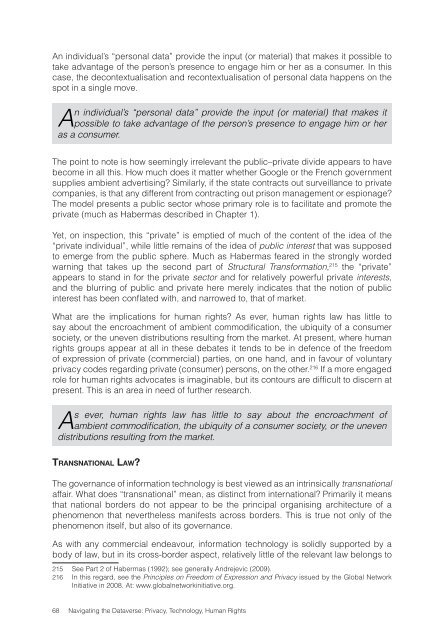Navigating the Dataverse: Privacy, Technology ... - The ICHRP
Navigating the Dataverse: Privacy, Technology ... - The ICHRP
Navigating the Dataverse: Privacy, Technology ... - The ICHRP
You also want an ePaper? Increase the reach of your titles
YUMPU automatically turns print PDFs into web optimized ePapers that Google loves.
An individual’s “personal data” provide <strong>the</strong> input (or material) that makes it possible to<br />
take advantage of <strong>the</strong> person’s presence to engage him or her as a consumer. In this<br />
case, <strong>the</strong> decontextualisation and recontextualisation of personal data happens on <strong>the</strong><br />
spot in a single move.<br />
An individual’s “personal data” provide <strong>the</strong> input (or material) that makes it<br />
possible to take advantage of <strong>the</strong> person’s presence to engage him or her<br />
as a consumer.<br />
<strong>The</strong> point to note is how seemingly irrelevant <strong>the</strong> public–private divide appears to have<br />
become in all this. How much does it matter whe<strong>the</strong>r Google or <strong>the</strong> French government<br />
supplies ambient advertising? Similarly, if <strong>the</strong> state contracts out surveillance to private<br />
companies, is that any different from contracting out prison management or espionage?<br />
<strong>The</strong> model presents a public sector whose primary role is to facilitate and promote <strong>the</strong><br />
private (much as Habermas described in Chapter 1).<br />
Yet, on inspection, this “private” is emptied of much of <strong>the</strong> content of <strong>the</strong> idea of <strong>the</strong><br />
“private individual”, while little remains of <strong>the</strong> idea of public interest that was supposed<br />
to emerge from <strong>the</strong> public sphere. Much as Habermas feared in <strong>the</strong> strongly worded<br />
warning that takes up <strong>the</strong> second part of Structural Transformation, 215 <strong>the</strong> “private”<br />
appears to stand in for <strong>the</strong> private sector and for relatively powerful private interests,<br />
and <strong>the</strong> blurring of public and private here merely indicates that <strong>the</strong> notion of public<br />
interest has been conflated with, and narrowed to, that of market.<br />
What are <strong>the</strong> implications for human rights? As ever, human rights law has little to<br />
say about <strong>the</strong> encroachment of ambient commodification, <strong>the</strong> ubiquity of a consumer<br />
society, or <strong>the</strong> uneven distributions resulting from <strong>the</strong> market. At present, where human<br />
rights groups appear at all in <strong>the</strong>se debates it tends to be in defence of <strong>the</strong> freedom<br />
of expression of private (commercial) parties, on one hand, and in favour of voluntary<br />
privacy codes regarding private (consumer) persons, on <strong>the</strong> o<strong>the</strong>r. 216 If a more engaged<br />
role for human rights advocates is imaginable, but its contours are difficult to discern at<br />
present. This is an area in need of fur<strong>the</strong>r research.<br />
As ever, human rights law has little to say about <strong>the</strong> encroachment of<br />
ambient commodification, <strong>the</strong> ubiquity of a consumer society, or <strong>the</strong> uneven<br />
distributions resulting from <strong>the</strong> market.<br />
Transnational Law?<br />
<strong>The</strong> governance of information technology is best viewed as an intrinsically transnational<br />
affair. What does “transnational” mean, as distinct from international? Primarily it means<br />
that national borders do not appear to be <strong>the</strong> principal organising architecture of a<br />
phenomenon that never<strong>the</strong>less manifests across borders. This is true not only of <strong>the</strong><br />
phenomenon itself, but also of its governance.<br />
As with any commercial endeavour, information technology is solidly supported by a<br />
body of law, but in its cross-border aspect, relatively little of <strong>the</strong> relevant law belongs to<br />
215 See Part 2 of Habermas (1992); see generally Andrejevic (2009).<br />
216 In this regard, see <strong>the</strong> Principles on Freedom of Expression and <strong>Privacy</strong> issued by <strong>the</strong> Global Network<br />
Initiative in 2008. At: www.globalnetworkinitiative.org.<br />
68 <strong>Navigating</strong> <strong>the</strong> <strong>Dataverse</strong>: <strong>Privacy</strong>, <strong>Technology</strong>, Human Rights
















